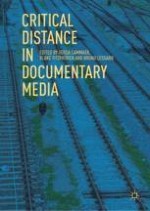2018 | OriginalPaper | Buchkapitel
Indexicality in the Age of the Sensor and Metadata
verfasst von : Craig Hight
Erschienen in: Critical Distance in Documentary Media
Aktivieren Sie unsere intelligente Suche, um passende Fachinhalte oder Patente zu finden.
Wählen Sie Textabschnitte aus um mit Künstlicher Intelligenz passenden Patente zu finden. powered by
Markieren Sie Textabschnitte, um KI-gestützt weitere passende Inhalte zu finden. powered by
